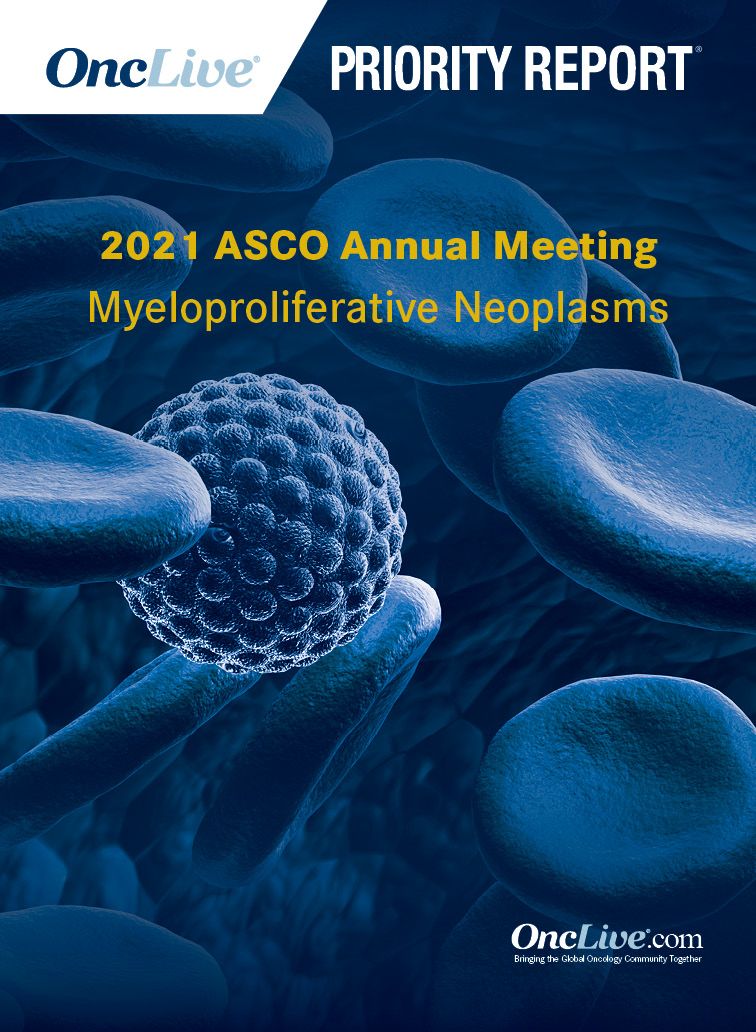Publication
Article
Supplements and Featured Publications
Symptom Improvement Appears Similar With Momelotinib Vs Ruxolitinib in Myelofibrosis
Author(s):
Momelotinib can provide clinically relevant and comparable improvement in overall symptom burden and individual symptom items compared with ruxolitinib in patients with intermediate- and high-risk JAK inhibitor–naïve myelofibrosis.
Ruben A. Mesa, MD

Momelotinib can provide clinically relevant and comparable improvement in overall symptom burden and individual symptom items compared with ruxolitinib (Jakafi) in patients with intermediate- and high-risk JAK inhibitor–naïve myelofibrosis, according to findings from an analysis of the phase 3 SIMPLIFY-1 trial (NCT01969838) that were presented as an abstract during the 2021 ASCO Annual Meeting and further expanded on as a poster during the virtual ISPOR 2021 Meeting.1,2
Meaningful improvements in symptom burden per Anchor-based Meaningful Change Threshold (MCT) Derivation were similar between patients in the overall population of SIMPLIFY-1 treated with momelotinib vs ruxolitinib. Moreover, 39% (n = 69) of patients treated with momelotinib (n = 175) demonstrated an improvement in symptom burden of at least 8 points compared with 41% (n = 77) of patients treated with ruxolitinib (n = 190). In the symptomatic cohort of patients, which were not included in the poster presentation, 56% vs 58% of patients achieved at least an 8-point improvement, respectively.
At week 24 after treatment initiation, the mixed effect models for repeated measures (MMRM) revealed mean within-subject improvements of 6.35 points with momelotinib vs 7.87 points with ruxolitinib, which both nearly reached but were less than the calculated study-specific within-subject 8-point MCT. In the symptomatic cohort, both treatment groups exceeded the MCT at 8.8 points vs 10.5 points, respectively.
“Item analyses and MMRM showed clinically important and comparable improvements in total symptom score [TSS],” Ruben A. Mesa, MD, director of the Mays Cancer Center at UT Health San Antonio MD Anderson Cancer Center, and co-authors.
Myelofibrosis is characterized by constitutional symptoms that cause significant burden on quality of life for patients. Although tools to evaluate patient-reported outcomes have improved in recent years, analytical methods to quantify symptom benefit with various therapeutic interventions have not improved significantly.
In the clinical trials evaluating JAK1/2 inhibitors, symptom improvement has generally been measured with a landmark analytic tool that requires a minimum 50% reduction in TSS from baseline over the last 28 days of a 24-week treatment cycle. Notably, however, patients with very high or low baseline TSS are required to reach significantly different absolute TSS improvements to be considered responsive to JAK inhibitor therapy.
The SIMPLIFY-1 trial failed to demonstrate noninferiority on the Myeloproliferative Neoplasm Symptom Assessment Form (MPN-SAF) response rate at week 24 with momelotinib vs ruxolitinib in 432 patients with intermediate- or high-risk JAK inhibitor–naïve myelofibrosis. The response rates were 28% vs 42%, respectively. However, each of the 7 TSS items evaluated—tiredness, early satiety, abdominal discomfort, night sweats, itching, bone pain, and pain under
the ribs on the left side—were similar between the momelotinib and ruxolitinib treatment arms.
“SIMPLIFY-1 is the only head-to-head phase 3 study comparing 2 highly active JAK inhibitors in the [myelofibrosis]-disease setting, yet was impacted by low symptom burden at baseline because of the failure to restrict enrollment to symptomatic subjects. SIMPLIFY-1 was also impacted by the heterogeneity in symptoms across [momelotinib] and [ruxolitinib] arms at baseline,” wrote Mesa and co-authors.
In order to evaluate the discrepancy between MPN-SAF response rates and TSS items, an item analysis and MMRM were applied to the data from SIMPLIFY-1.
The MMRM estimated the treatment effect difference by score change between momelotinib- and ruxolitinib-treated patients with myelofibrosis across the longitudinal 24-week period. Factors analyzed included treatment, time, treatment-by-time interaction, age, race, and baseline TSS. These were included as fixed and random covariates.
The TSS individual item analysis compared baseline measures with health state shift scores at week 24. The 11-point scale measured health states by none (score of 0), mild (1-3), moderate (4-6), severe (7-9), or very severe (10).
Further results revealed that 29 patients in the overall population treated on SIMPLIFY-1 experienced a very much improved symptom burden, followed by much improved (n = 156), minimally improved (n = 108), no change (n = 36), minimally worse (n = 12), and much worse (n = 7).
Treatment effect for the between-treatment group comparison was 1.52 points in the overall population compared with 1.67 points in the symptomatic population based on a 70-point scale.
Additionally, findings from cumulative distribution function curves reported comparable distributions of change from baseline irrespective of treatment in both the overall and symptomatic cohorts. The median numerical change in MPN-SAF TSS from baseline to week 24 was 4.69 points with momelotinib (n = 178) vs 5.36 points with ruxolitinib (n = 196) in the overall population. In the symptomatic population, the median numerical change in MPN-SAF TSS was 8.57 points with momelotinib (n = 123) vs 9.63 points with ruxolitinib (n = 132).
Regarding specific symptoms, no or mild symptoms were reported in 44% to 81% of patients in the overall population. Tiredness was most prevalent and severe at baseline in this patient population, whereas early satiety was mostly mild with a large proportion of patients not reporting baseline itchiness.
“The individual items provide a heterogenous contribution to the baseline TSS value. The distribution of baseline scores in the symptomatic subgroup was consistent with the overall population,” wrote Mesa and co-authors.
Patients receiving momelotinib were more likely to report severe or very severe scores at baseline compared with patients receiving ruxolitinib; however, the proportion of patients who reported severe or very severe symptoms at baseline decreased similarly for both treatment cohorts at week 24. Likewise, the proportion of patients who reported none or mild symptoms increased similarly for both cohorts at week 24.
Specifically, a 20.7% increase was observed in the number of patients receiving momelotinib who reported none/mild tiredness compared with a 17.4% increase in those receiving ruxolitinib. In the symptomatic population, a 31.3% vs 26.4% increase was observed, respectively.
“The magnitude of improvement in [momelotinib] versus [ruxolitinib] was similar for all items in the overall population and symptomatic population,” wrote Mesa and co-authors.
Finally, the likelihood of improvement on individual symptom items appeared to be similar for patients treated with momelotinib vs ruxolitinib in both the overall and symptomatic populations.
“Imbalance in baseline symptom scores in [momelotinib] subjects may have contributed to the inability to demonstrate non inferiority in TSS response rate at week 24. These analyses require further validation in independent data sets on the basis of the modified MPN-SAF,” concluded Mesa and co-authors.
References
- Mesa RA, Hudgens S, Floden L, et al. Longitudinal and individual symptom analyses of momelotinib and ruxolitinib treated myelofibrosis patients from SIMPLIFY-1. J Clin Oncol. 2021;39(suppl 15):e19040. doi:10.1200/JCO.2021.39.15_suppl.e19040
- Mesa RA, Hudgens S, Floden L, et al. Beyond a binary endpoint: longitudinal and individual symptom analyses from the SIMPLIFY-1 study demonstrate clinically comparable symptomatic benefit of momelotinib to ruxolitinib in JAK inhibitor naïve myelofibrosis patients. Presented at: Virtual ISPOR 2021; May 17-20, 2021; virtual. Abstract 109778.










